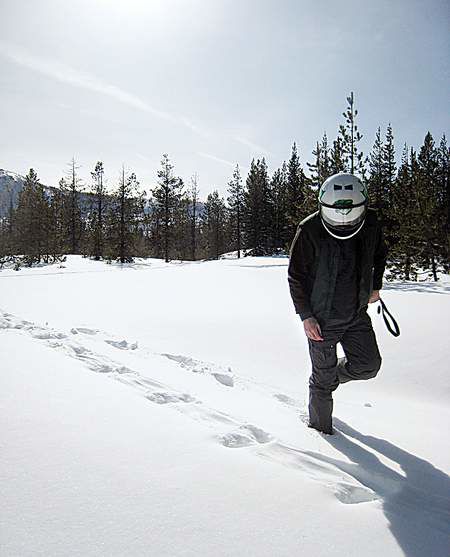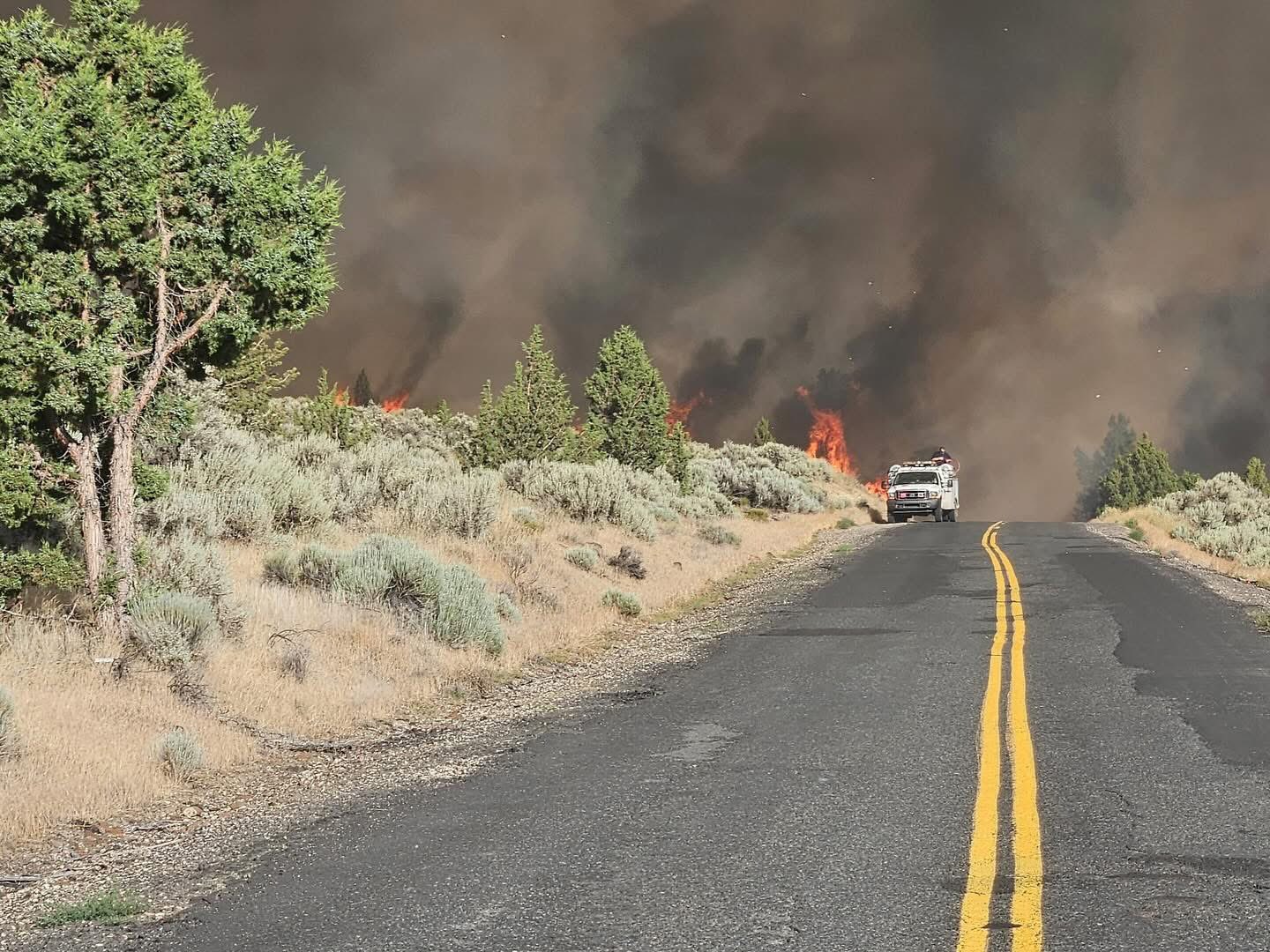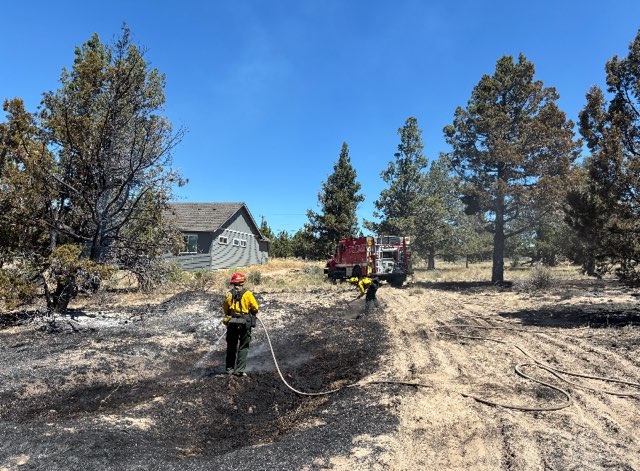A wolf here? Not likely
Published 5:00 am Monday, March 16, 2009

- John Stephenson, with the U.S. Fish and Wildlife Service, investigates tracks of an animal — definitely not a wolf — that appeared to be low to the ground and moving quickly. Stephenson snowmobiled through the Sisters Ranger District on Friday, seeking evidence of wolves.
The 5-inch-wide paw prints had potential.
“It’s the right size,” said John Stephenson, Or-egon’s wolf coordinator with the U.S. Fish and Wildlife Service, gauging the track’s length and width with a wooden ruler. “It’s interesting.”
Trending
But not convincing, he concluded after a little investigation. Stephenson’s verdict: The prints were probably left by someone’s pet dog.
And he was looking for something a little wilder.
Stephenson was on the hunt Friday for signs that a wolf or a wolf hybrid, caught on camera by a driver on Santiam Pass six weeks ago, still roamed the area.
“It’s a long shot,” he acknowledged.
It’s been decades since wolves lived in the Central Cascades, as the animals were killed off in Oregon in the 1940s. But as reintroduced wolves start making their way into the state from Idaho, wildlife managers are in the field to watch for them. The biologists search for wolf tracks, howl to see if anything howls back, and try to trap wolves and fit them with radio collars.
While most of the work is going on in northeastern Oregon, recent sightings of large canids in the Cascades have brought the search for wolves to Central Oregon.
Trending
In late January, passengers in two different cars saw a dark, wolflike animal cross Santiam Pass.
Stephenson later followed its tracks south for several miles. After that sighting, one person reported seeing a similar animal near Crater Lake, while another person reported seeing it near Suttle Lake. The Fish and Wildlife Service has received additional reports recently of a different animal, one with a lighter gray coat, in the area as well.
“This sighting generated a tremendous amount of public interest,” Stephenson said of the Santiam animal. And it’s the job of wildlife managers like him to follow up and see whether the animal is still there.
Tracking
But finding a wolf in a forest is not a simple proposition.
“Everybody seems to think it’s really easy,” Stephenson said. “But there’s a lot of forest out there, and you’re looking for one, maybe two animals.”
The trick is to cover as much ground as possible, he said.
So Friday, Stephenson and Jeremy Fields of the U.S. Forest Service revved up snowmobiles and navigated the maze of logging roads around Cache Mountain. Stephenson has been out in the area several times — on foot and on skis — looking for the wolf, but this time the Forest Service snowmobiles were providing the horsepower. Fields, a pre-sale forester with the Sisters Ranger District, had never been out wolf tracking, but he came out on his day off to help.
They started from a parking lot off of the McKenzie Highway, about seven miles west of Sisters, and followed well-tracked snowmobile paths on Forest Road 1028.
Patches of bare ground poked through the snow in places, and Stephenson noted that with several more warmer, sunny days like Friday, the cover would be gone, and finding wolf tracks would be very difficult until next winter brings more snow.
But Friday, the timing was perfect for tracking, he said. Fresh snow fell early in the week, followed by dry weather, providing a blank canvas for animal prints.
“This is probably the best opportunity to see if there’s something still running around,” he said.
With the machine kicking up snow behind him, Stephenson glanced left, glanced right, and scanned the snowbanks for tracks. While a snowmobile flying down the trail at 30 or 40 miles per hour would scare off most animals, the shadows and contours of prints animals had left in the smooth snow were easy to pick out on the clear day.
Stephenson stood up on the machine with his knee on the seat, checking out prints left by coyotes, squirrels, bobcats and people between trees and along the trail.
A few miles in, he stopped. A straight line of deep prints, spaced a couple of feet apart just like a wolf’s tracks would be, crossed the trail.
He cut the snowmobile’s engine and waded through the snow to get a closer look.
But the tracks, at 2 inches wide, were about a third too small.
And nearby, the prints of a snowshoe hare bounding across a clearing provided a likely backstory to explain the prints — a coyote chasing after a potential meal.
But he’d been excited for a minute there, Stephenson said before heading back to the snowmobile.
He pulled the rip cord a couple of times to start up the stubborn machine, then bounced across the tracked-up snow, looking left and right again.
Using the multiple maps stuffed in his pockets, he guided the tracking party across a route involving both well-used snowmobile trails and unbroken paths that led up, down and along hillsides. Behind the trees, views of Mount Jefferson, Mount Washington and Black Butte were so clear that the butte’s fire lookout was visible from several miles away.
Plenty of animals had been out and about.
Stephenson pointed out bobcat prints, and followed a cougar’s prints over snow-covered bushes and branches.
Cat prints are asymmetrical compared to dog tracks, he noted, tracing the imprint of the cougar’s two front toes, pointing out where the big cat’s retracted claw still left a mark. Prints from members of the feline family are also usually about as wide as they are long, he said, while canine prints are longer.
But one set of odd prints in the snow along one road stumped him.
“We’re going to have to consult the books on that one,” Stephenson said, taking off his helmet to snap pictures of tracks where a low-clearance animal had passed by. In between pairs of prints, the snow was slicked down as if something’s belly was dragging along.
It could be a badger, he considered, but it would have to be a pretty big one to make prints so far apart.
“Whatever it was, it was having a good time,” Stephenson said, looking at a short but steep incline where the paw prints disappeared and the animal had slid for a good 10 feet or so, leaving a smoothed out, squiggly path down and around a couple of trees.
Back on the snowmobile, through dense conifer forests and across sparse hills scorched by the G.W. Fire, Stephenson and Fields covered almost 34 miles.
Animal prints followed logging roads and cut across trails, but the prints were small or the patterns weren’t those of a wolf on the move.
No trace
The snow provided no evidence of the dark animal that ran across Santiam Pass, or the second gray animal some had reported.
“If there was a pair of animals out there, I think we would have seen something,” Stephenson said.
The canid spotted on Santiam was probably a lone animal, he said, wandering through the area.
“If it’s just by itself, it’s likely we’ll never see it again,” Stephenson said.
These single wolves leave the pack they were born in and settle somewhere else, where they can have their own territory. The Central Cascades have lots of open habitat, Stephenson said, but not many other wolves for a single wolf to pair up with — and wolves are more likely to survive with others to help with hunting prey.
Sightings of lone wolves are interesting, said Russ Morgan, wolf coordinator with the Oregon Department of Fish and Wildlife. But they aren’t as significant as having a pair of wolves or a pack settling in an area, establishing a home range.
“One animal doesn’t really make a population,” Morgan said.
While the federal Fish and Wildlife Service decided recently to delist wolves in the Northern Rockies area, they are still considered federally endangered in Oregon west of Pendleton and Burns. Oregon’s state wolf plan calls for the animals to be protected as endangered species until there are four breeding pairs east of U.S. Highway 97 for three consecutive years, the population size the state has set as a goal.
The agencies rely on solid data — like tracking surveys — to keep track of the number of animals and pairs, determine what habitat they’re using and figure out where to focus the attention of wildlife agencies, Morgan said.
Finding no traces of wolves is valuable information as well, he said, and repeated surveys will just add to the amount of data biologists have.
“Trying to track a population, whether it’s increasing or decreasing, you really have to start somewhere,” Morgan said. “And that somewhere could be zero … You just never know any of this unless you go out and look.”
Stephenson said if he had found wolf tracks, the next step would have been to go out and howl to see if a wolf or wolves howled back.
“But howling is such a needle in a haystack if you don’t have evidence of an animal,” he said.
Tracking wolves is what led Stephenson and Morgan to an area in Northeast Oregon, and when biologists followed up on the prints and howled there last summer, they heard pups answer back.
With no new signs of resident wolves in Central Oregon, Stephenson said, the focus now shifts back to Northeast Oregon and trying to radio collar wolves there.
While the Oregon biologists believe they have a breeding pair and might have a second one this spring, other wolf experts aren’t convinced, Stephenson said. Trapping and tagging an animal, and taking blood samples, would prove their presence.
“It’s unofficial,” he said. “We’d like to make it official.”








